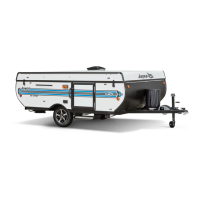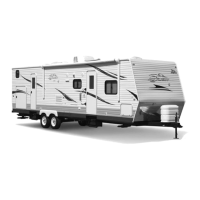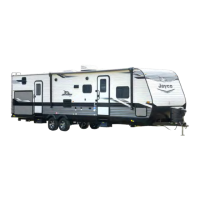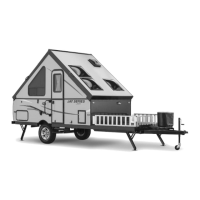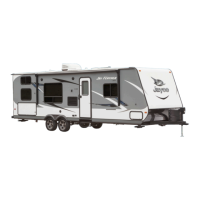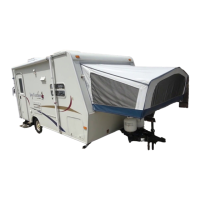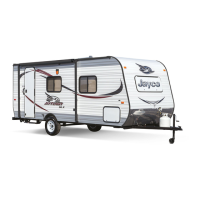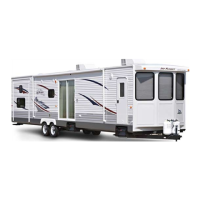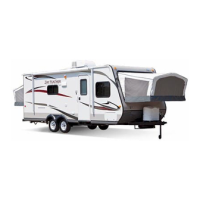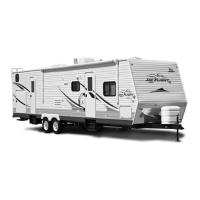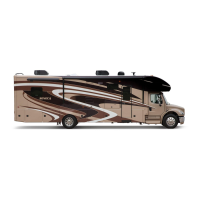through the hole in the middle of the center
spacer bar “D.” Compress the tension
rafter and place it in the center of the roof
side board, as pictured. The metal tip from
the tension rafter will rest against the roof
metal or the canopy bag.
4. If no screen room is being installed, repeat
step #3 on the front and rear tension rafter,
inserting the end of the tension rafter
through the snap button poles “B” and the
end divider bars “C.” Position the tension
rafter as in step #3.
5. After all the poles are installed:
a. Adjust the canopy to fit properly.
b. Adjust the height of the canopy with the
snap button poles.
c. Install the three stakes to anchor the
canopy in case of strong winds.
Maintenance
Keep your canopy in good condition to prevent
costly repairs. It is very important to keep the
canopy clean. If weather conditions are windy
or stormy, close the canopy into the travel
mode position. Shut the canopy in the travel
position if you will be away from the RV. Heavy
rain can damage both the canopy fabric and
the poles if it is allowed to “pocket” on the
fabric. It is very important to have the correct
slope in the canopy. The side of the canopy at
the twist poles should be about 19” lower than
the side that is attached to the awning rail on
the roof. If rain is anticipated, lower one side to
allow adequate run off. The canopy is to be
removed for winter storage due to winter
condensation accumulation.
ALWAYS roll up your canopy dry. If you ever
need to roll up the canopy when it is wet, unroll
it within 24 hours and allow it to dry. Mildew will
develop on damp and wet canopies. Be sure to
follow the list of Do’s and Don’ts below when
caring for your canopy.
DO...
0 Keep your canopy clean. This is the best
protection against mildew. Even on mildew
resistant fabric, mildew can grow on
accumulated dirt or foreign materials
which remain on the top or bottom surface.
This will eventually damage or stain the
fabric. We cannot be responsible for such
damage.
0 Wash down your canopy; brushing lightly
with a cloth or soft brush.
0 Hose your canopy down occasionally
(every month) with a garden hose. We
recommend doing this on a hot, sunny
day.
0 Keep the underside of your canopy clean
by simply brushing it with a clean
household broom. The underside can be
washed in the same manner as the top.
0 Keep shrubbery and vines away from the
canopy, as many bushes contain acid
which can be harmful.
DO NOT...
0 Fold or roll in extreme cold temperatures.
0 Drag your canopy across any abrasive
surfaces, such as a cement drive.
0 Get insect spray on the fabric, as some
solutions may impair the water repellency
of the fabric and cause staining.
0 Allow water to stand on the canopy,
causing pocketing and possible stretching.
0 Wash your canopy with a harsh strong
solution, or scrub too vigorously with an
abrasive cleaner.
0 Force or yank your canopy when raising or
lowering it. Do it gradually.
0 Charcoal grill underneath the canopy.
0 Store the canopy when it is damp or wet.
Mildew is a fabric’s greatest enemy and is
caused by dampness. Mildew may grow
on the surface of a damp canopy and
permanently stain the fabric.
0 Permit leaves, twigs, etc. To remain on
your canopy as they might cause a
staining of the fabric.
0 Wrap steel or aluminum hardware with the
canopy.
75
SECTION 8
CAMPING & OPERATING

